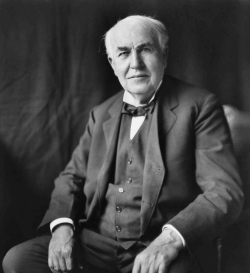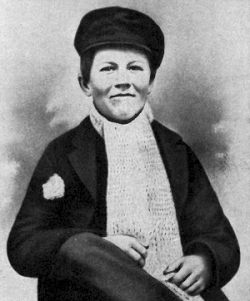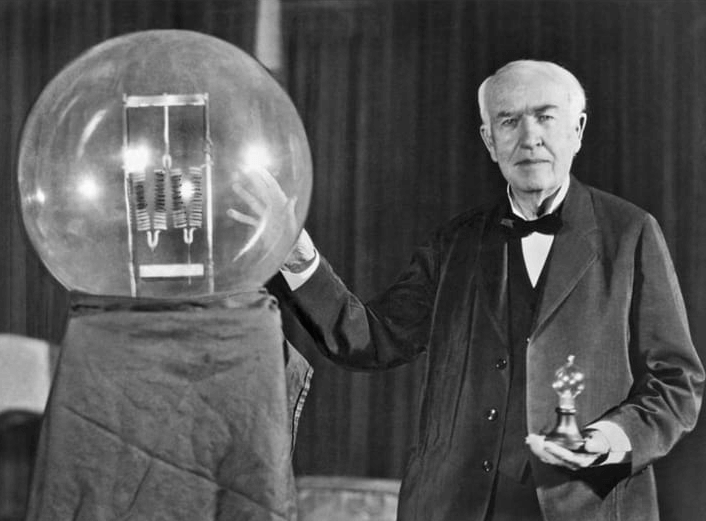Thomas Alva Edison
Thomas Alva Edison was regarded as a true jewel in the field of inventions since he was one of the most inventive inventors of all time. He also devoted a sizable portion of his life to creating designs that had a profound impact on contemporary life. Some of his amazing discoveries include the development of the phonograph, the motion picture camera, the incandescent light bulb, mechanical vote recorder, stock ticker, practical electric light bulb, electric car battery and improvements to the telephone and telegraph systems. Thomas Alva Edison was not only a brilliant inventor and businessman, but he also changed people's lives by making significant advancements in a variety of sectors. Thomas Alva Edison was a remarkable American inventor who also holds the record for over 1000 patents in history, i.e., a total of 1093 patents (singly or jointly). Additionally, he founded the first industrial research lab in history. Edison was born in Milan, Ohio, on February 11, 1847. Mass communications and telecommunications have benefited greatly from Edison's patents and other inventions. In his early years, he offered newspapers to people using the Grand Trunk Railroad. This inspired him to launch the "Grand Trunk Herald", his own newspaper. This newspaper's availability of current information quickly gained popularity with the general public. Additionally, it was Edison's first of many future business operations. Early Years
In 1847, Thomas Edison was born in Milan, Ohio; however, his family moved to Port Huron, Michigan, in 1854, where he spent his formative years. Originally from Marshalltown, Nova Scotia, he was the seventh and last child of Nancy Matthews Elliott (1810-1871) and Samuel Ogden Edison Jr. (1804-1896). His patrilineal ancestral line originated in the Netherlands via New Jersey; the surname was "Edeson" originally. After joining the Rebellion of 1837, his father immigrated to Vienna, Ontario, and later left the place. John Edeson, his great-grandfather, left New Jersey for Nova Scotia in 1784. His mother, a former teacher, instructed Edison in reading, and writing, as well as understanding basic concepts of maths. He just spent a brief period of time in school. However, according to some sources, he was a very curious boy who discovered the majority of topics by reading on his own. He developed a fascination for technology as a child and spent many hours conducting experiments at home. At the age of 12, Edison started having hearing issues. It has been determined that a childhood case of scarlet fever and ongoing, untreated middle ear infections are what caused his deafness. He then created intricate, made-up tales regarding the origin of his deafness. Edison reportedly clamped his teeth into a music player or piano to absorb the sound waves into his brain because he was entirely deaf in one ear and hardly hearing in the other. As he became older, Edison thought his hearing loss helped him focus more readily and avoid distractions. He once stated that "My deafness has not been a handicap, but a help to me". Initial CareerBeginning his career, Thomas Edison hawked vegetables, sweets, and newspapers aboard trains going from Port Huron to Detroit. He was earning around $50 a week by the time he was 13 years old, most of which he spent on materials for his electrical and chemical experiments. He later became a telegraph operator after saving 3-year-old Jimmie MacKenzie from being run over by a train. Jimmie MacKenzie's father, J. U. MacKenzie, a station agent in Mount Clemens, Michigan, was so grateful that he showed Edison how to use a telegraph. The Grand Trunk Railway's Stratford Junction, Ontario, station was where Edison's first telegraphy position outside of Port Huron was located. He was blamed for a potential collision. Prior to quitting his work, he performed chemical experiments on the train while studying qualitative analysis. The Grand Trunk Herald was created by Edison with the assistance of four staff and distributed together with his other papers. Edison had been granted the sole permission to sell newspapers on the route. As he began to realise his potential as a businessman, this marked the start of Edison's lengthy streak of entrepreneurial endeavours. In the end, General Electric, which is today one of the largest publicly traded businesses in the world, was founded as a result of his entrepreneurial spirit. Thomas Edison as a Scientist
His most significant creation, an industrial research lab, was established by Edison in 1876. Edison allegedly used a music player or piano to clamp his teeth into it in order to experience sound waves in his brain because he was entirely deaf in one ear and hardly hearing in the other. After witnessing the telegraph in action, Edison was doubtful whether his first price estimate of $4,000 to $5,000 was accurate, so he requested an offer from Western Union. He was shocked when he got a $10,000 bid. The quadruple telegraph was Edison's first significant financial success, and Menlo Park was the first company dedicated to constant technological improvement. Despite the fact that a number of employees worked on research and development projects there while Edison was in charge, he received legal credit for the majority of the innovations. His team typically followed his orders when performing research, and he exerted strong pressure on them to produce results. Utility patents, which had a 17-year lifespan and included electrical, mechanical, or chemical ideas or procedures, made up the majority of Edison's inventions. There were about a dozen design patents which protected decorative designs and were valid for up to 14 years. Like most patents, the inventions he listed were improvements over state of the art. On the other hand, the phonograph patent was the first to mention a mechanism that could record and reproduce sounds. PhonographThe phonograph, which Edison invented in 1877, is what made him famous. Edison started out as an inventor in Newark, New Jersey, with the automatic repeater and other improved telegraphic equipment. This accomplishment seemed almost supernatural to the broader public because it was so unexpected at that time. After this invention, Edison was known as the "The Wizard of Menlo Park". His first phonograph recorded music using tinfoil that was wrapped around a grooved cylinder. Edison rose to fame as a result of the phonograph, despite the device's subpar audio quality and limited playback capabilities. Electric LightIn order to compete with lighting based on gas and oil, Edison began developing an electrical lighting system in 1878. He began by making an effort to develop a long-lasting incandescent lamp, which was required for indoor use. Thomas Edison, however, could not create the light bulb. In 1840, British scientist Warren de la Rue developed a strong light bulb with a platinum filament that was wound tightly. However, the exorbitant price of platinum hindered the light bulb's commercial success. Among the numerous other inventors who came up with incandescent lamps were Henry Woodward, Mathew Evans, and Alessandro Volta, who demonstrated a lighting wire in 1800. In 1878, Thomas Edison founded the Edison Electric Light Company in New York City with the assistance of additional financiers, including J. P. Morgan, family relatives of the Vanderbilts, P. Morgan, and Spencer Trask. Edison gave the first public demonstration of his incandescent light bulb on December 31, 1879, in Menlo Park. Carbon Telephone TransmitterTo improve the microphone for telephones, Edison created a carbon microphone in 1876. It consisted of two metal plates separated by carbon granules, and the resistance that varied depending on how strongly sound waves were applied (at the time called a "transmitter"). The granules acted as a conduit for a steady direct current, which was modulated by the granules' variable resistance. This fluctuating electric current was used to mimic the pressure variations of the sound wave. Up until that moment, Mic, like those developed by Johann Philipp Reis and Alexander Graham Bell, functioned by producing a weak current. A direct current was modulated in order for the carbon microphone to work, and after that, a transformer was used to send the signal to the phone line. By regulating an electrical current flowing through it, many innovators attempted to create a useful microphone for telecommunications. Among them was Edison. Both David Edward Hughes' research and published paper on the physics of loose-contact carbon transmitters and Emile Berliner's loose-contact carbon transmitter later lost a patent lawsuit against Thomas Edison- all completed simultaneously. Hughes, however, neglected to file for a patent on his work. Distribution of Electric PowerEdison founded an electric "utility" on October 21, 1879, to compete with the already-existing gas light utilities after creating a commercially effective electric lightbulb. On December 17, 1880, he established the Edison Illuminating Company. He also developed and patented an energy distribution system during this time. In New York City's Pearl Street Station, the business established the first investor-owned electric service in 1882. Edison's Pearl Street producing station provided 110 volts of direct current (DC) to 59 clients in lower Manhattan when he turned on the electrical power distribution system on September 4, 1882. FluoroscopyEdison created and produced the first fluoroscope, a device that employs X-rays to take radiographs, which was made and sold commercially. The device could only produce very feeble images until Edison realised that Wilhelm Röntgen's barium platinocyanide fluoroscopy screens produced sharper images. Despite the fact that Edison abandoned up on the project after seriously injuring his assistant Clarence Dally and coming dangerously close to losing his vision, the basic design of his fluoroscope is still in use today. Dally agreed to serve as the fluoroscopy experiment's human test subject and received a deadly dose of radiation; he later passed away (at the age of 39) from complications arising from the exposure, including mediastinal carcinoma. Telegraph UpgradesHis contributions to the realm of telegraphy helped establish Edison's early fame and popularity. After years of training as a telegraph operator, he became an expert in electrical mechanics. He made a fortune with the stock ticker, the first electricity-based broadcast device, early thanks to him and his chemical education at Cooper Union. He later created the quadruplex, the first device, among other things, that was capable of sending four messages at once via a single cable. Motion Picture CameraThomas Edison was the first to grant a patent for the motion picture camera, sometimes referred to as the "Kinetograph". Both efficiency and weight were promised. Customers could use them to power up their phonographs, but they also saw uses for them in other areas, such as electric vehicles. In 1891, Thomas Edison created the Kinetoscope, sometimes known as a peephole viewer. On this screen, which was put in penny arcades, people could view quick, simple movies. On May 20, 1891, the Kinetoscope and Kinetograph made their public debuts. The Edison plant built the Vitascope, which Thomas Armat developed, and it was initially used to project moving images at open-air screenings in New York City in April 1896. Later, he displayed movies that had mechanically synced spoken soundtracks recorded on cylinders and played in time with the visual. Rechargeable BatteryIn the late 1890s, a rechargeable battery known as an "accumulator" was developed by Edison. However, it was supposed to be more efficient and lighter. Customers could use them to run their phonographs, but he also envisioned the potential for them in other things, like electric vehicles. Edison sought the use of alkaline rather than acid because the lead-acid rechargeable batteries on the market at the time were ineffective, and the market had already been controlled by other companies. Before deciding on a nickel-iron combination, he conducted a lab experiment with a wide range of materials (more than 10,000 combinations). Edison established the Edison Storage Battery Company in 1901 after receiving the US and European patents for his nickel-iron battery. By 1904, the company employed around 450 workers. The initial rechargeable batteries they produced were for electric automobiles; however, the product had a number of problems that resulted in complaints from customers. When the company's funding was exhausted, Edison paid for it with his own money. Edison did not reveal a fully developed device until 1910: a nickel-iron battery with lye as the electrolyte that was highly effective and long-lasting. FamilyAt the age of 24, Edison married a young 16-year-old girl named Mary Stilwell. It is being told that he had met her only two months before the wedding. Edison and Mary had three children named Marion Estelle Edison, Thomas Alva Edison Jr., and William Leslie Edison. Unfortunately, Mary died on August 9, 1884, at the age of only 29. According to sources, she died possibly due to a brain tumour or morphine overdose. After the death of Mary Stilwell, Edison married to Mina Miller on February 24, 1886, at the age of 39. With Mina, Edison also had three children: Madeleine Edison, Charles Edison, and Theodore Miller Edison. DeathEdison died in his home on October 18, 1931. It is referenced from several sources that he died due to complications of diabetes. After his death, he was buried behind his "Glenmont" home in Llewellyn Park in West Orange, New Jersey. To show respect and honour, Edison's last breath was contained in a test tube and later transferred to the Henry Ford Museum near Detroit. It also keeps other memorabilia related to Edison as souvenirs.
Next TopicBal Gangadhar Tilak
|
 For Videos Join Our Youtube Channel: Join Now
For Videos Join Our Youtube Channel: Join Now
Feedback
- Send your Feedback to [email protected]
Help Others, Please Share









